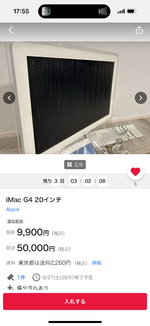I have a few 17" Apple Studio Display M7649 on hand. I bought another one with a broken stand. When I got it home, it would power on, but not illuminate. I have another one that comes on but then powers off after 5-10 seconds. So with two bad ones, I was hoping to piece together one good working one. I started with some disassembly and swapped inverter boards to verify the boards and the CCFLs. The result is that one inverter is bad, one is half dead. One set of CCFLs is hanging on, and the other is completely dead.

Using the pinout on the main board, I used a multimeter to test voltages of both units while powered on and off so I had a good idea of what I was dealing with. I never got the real 28v as Apple specifies, only somewhere between 24-25v.

During the PPC Challenge 2025, I purchased some LED strips to put into a couple of older laptops, but never completed those tasks. The strips are about an inch short, but I thought I would give it a go and see if they would work in this display. I disassembled further with no guidance (iFixIt only has a reference to inverter exchange, nothing about the CCFL swap).

That was a little too far. I did not need to disassemble that much. Hindsight, I found the tiny Phillips screw to remove the CCFL.

But I also found the real LCD part number.

These are the LED "inverters" or drivers that came with the LED strips. The eBay sale said 9-24V, and the silkscreen on the back says 28V. I didn't want to get near the limit, so I included a voltage drop to 15V.

I created a new wiring harness to take the 24-28 to 15V, then to the drivers. (original for comparison)

This includes a simple two resistor voltage divider to get a 0.2V to the "inverter OK" line telling the control board that the drivers are working. 100-Ohm and 22k-Ohm.

Tuned the voltage to 15V when off, and when on, I get a small drop (expected).

First test of wiring and electronics, LEDs not installed yet.

The CCFLs had a small rubber stopper on each end of the illumination slides. I 3D printed in clear PTEG some replacements to hold the ends of the LED strips.

The face was slightly yellowed and dirty, so I cleaned slightly for dust but no de-yellowing action taken.

LED strips installed, just testing for power and light, verifying the Display controller board actually created an image (VGA monitor in the background to verify OS was running).

There is some light leakage, but once fully assembled, I am sure it won't be noticeable.

Full testing but not fully assembled. I am still 3D printing a 'tray' to hold the electronics. For now they are held in with double stick foam tape. Looks really cool with the back off.

And the brightness adjustment works!

The corners are a bit dimmer, but that is expected as my LED strips were a little short. I will order a longer pair for the other display.

Using the pinout on the main board, I used a multimeter to test voltages of both units while powered on and off so I had a good idea of what I was dealing with. I never got the real 28v as Apple specifies, only somewhere between 24-25v.
During the PPC Challenge 2025, I purchased some LED strips to put into a couple of older laptops, but never completed those tasks. The strips are about an inch short, but I thought I would give it a go and see if they would work in this display. I disassembled further with no guidance (iFixIt only has a reference to inverter exchange, nothing about the CCFL swap).
That was a little too far. I did not need to disassemble that much. Hindsight, I found the tiny Phillips screw to remove the CCFL.
But I also found the real LCD part number.
These are the LED "inverters" or drivers that came with the LED strips. The eBay sale said 9-24V, and the silkscreen on the back says 28V. I didn't want to get near the limit, so I included a voltage drop to 15V.
I created a new wiring harness to take the 24-28 to 15V, then to the drivers. (original for comparison)
This includes a simple two resistor voltage divider to get a 0.2V to the "inverter OK" line telling the control board that the drivers are working. 100-Ohm and 22k-Ohm.
Tuned the voltage to 15V when off, and when on, I get a small drop (expected).
First test of wiring and electronics, LEDs not installed yet.
The CCFLs had a small rubber stopper on each end of the illumination slides. I 3D printed in clear PTEG some replacements to hold the ends of the LED strips.
The face was slightly yellowed and dirty, so I cleaned slightly for dust but no de-yellowing action taken.
LED strips installed, just testing for power and light, verifying the Display controller board actually created an image (VGA monitor in the background to verify OS was running).
There is some light leakage, but once fully assembled, I am sure it won't be noticeable.
Full testing but not fully assembled. I am still 3D printing a 'tray' to hold the electronics. For now they are held in with double stick foam tape. Looks really cool with the back off.
And the brightness adjustment works!
The corners are a bit dimmer, but that is expected as my LED strips were a little short. I will order a longer pair for the other display.
Last edited:

